Times are certainly challenging for hospitality businesses. According to the BBC, job vacancies are at their highest since records began.
But in fact, there’s nothing new about that. Since 2017 vacancies in hospitality have been around the 90,000 + mark consistently. So as it’s a long-term issue and unlikely to change – what can be done to attract and retain talent? And should this current crisis actually be seen as an opportunity to improve?
Better pay and conditions
Rightly or wrongly, hospitality is seen as a low wage and long hours industry. Paradoxically, it is also an industry reliant on zero-hour contracts. For those in salaried positions, it is not much better as often a 40-hour contract can involve working a 60-hour plus week.
In the new post-pandemic world with its highly demanding workforce and focus on wellbeing, restaurant leaders need to ensure a better working model. This can include:
- Improved staff training
- Management strictly enforcing rules on working hours
- Removing reliance on zero-hour contracts
Improving work life balance
While it’s true many chefs have traditionally worked 14-hour days, it is also true that there is also a great deal of flexibility in the business.
Restaurateurs can lead the way by highlighting the positive work life balance aspects of the industry. The ability to work shifts, for example, can be fitted around childcare or study.
Similarly, rather than relying on a pool of overseas labour restaurateurs can recruit from available members of society, such as retirees, many of whom may welcome the opportunity to earn extra income. There’s also a push at the moment to encourage businesses to recruit former offenders who have paid their dues and are looking for a positive new start.
Better scheduling
With a finite resource such as labour it is important that your technology toolkit includes a robust solution for managing staff schedules.
Supporting your scheduling with data insights is the most efficient and cost-effective way to ensure customer service levels are as high as possible.
The most effective tools are integrated with your restaurant EPOS system. The data from your restaurant EPOS system is invaluable for gauging future peaks and troughs in labour demand.
Using this technology, you can:
- Schedule labour based on historic spend patterns
- Dynamically change labour schedules to meet current demand
- Enforce stricter labour scheduling to minimise unpaid overtime
- Produce up to date staff rosters in seconds
4 ways to improve efficiency with technology
Of course, scheduling labour is only one aspect of the equation. You need to ensure that you are running a tight ship. Manual processes need to be eliminated and replaced by technology.
By streamlining your operation, you can reduce the demand for labour thus mitigating the effects of any labour shortages.
Technology can help in these 4 ways:
1. Handheld ordering – increases order throughput and the efficiency of your order process. By removing error-prone processes such as the use of handwritten chits orders can be pushed through to the kitchen automatically.
Integration with the restaurant EPOS system removes one more error-ridden element of the ordering process – no more need for staff to punch in orders at the till.
The productivity of your staff can soar – they can attend to several tables at once and use the technology for queue-busting during busy periods.
2. Kitchen display systems – integrating the order process with kitchen display systems saves even more time. Orders can be seen automatically on the kitchen screens.
Did you know: On average our clients are saving two hours a day using the KDS and in addition it eliminates the ancillary costs of kitchen printers and paper. The accuracy of the solution also ensures that there is much less wastage.
3. Labour management – integration of the enterprise reporting suite with the restaurant EPOS system gives you a wealth of historic sales data which you can use to intelligently predict future labour needs. By the same token, real-time sales data using a mobile reporting system enables you to make quick decisions when you need to recalibrate your labour.
4. Menu management – reduced staff and supply chain shortages may necessitate a shorter menu. Having access to sales data from the restaurant EPOS system gives you an insight into what profitable items you need to keep on your menu and what you can safely jettison.
Time savings can also be made by using a cloud-based enterprise solution to manage the menu. Menu changes can be made at the touch of a button across a whole estate and when integrated with digital signage those changes are instant. So much time and printing ink is saved.
Conclusion
While labour shortages are a real threat to the industry there are measures you can take today to attract talent while at the same time introducing more efficient processes driven by technology.
Technology can help restaurateurs make informed choices about their labour requirements, and using an integrated approach they can eliminate many pointless and time-consuming tasks.
Digital transformation is the way forward – check out our video to see how it can positively impact your business.
















